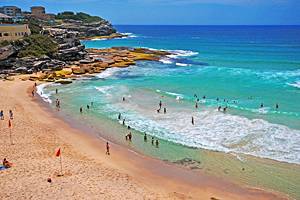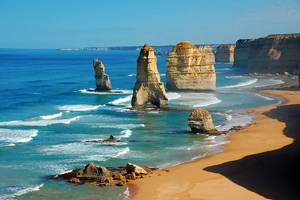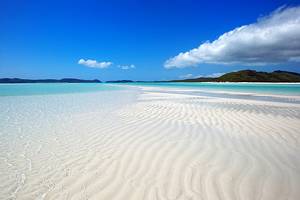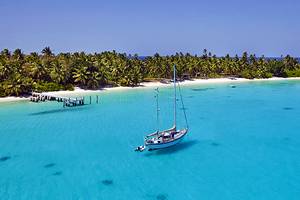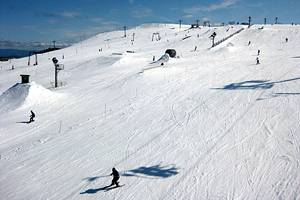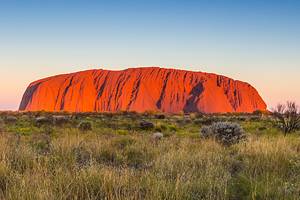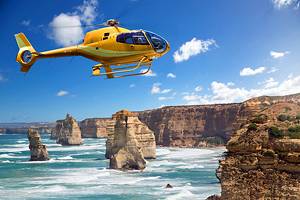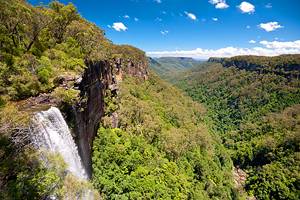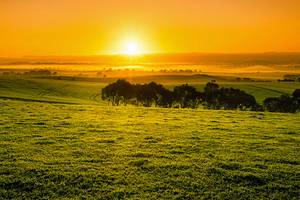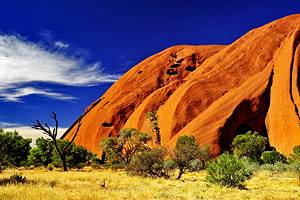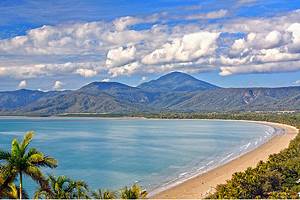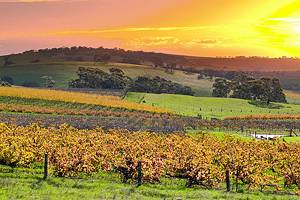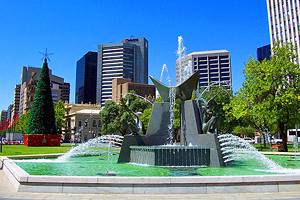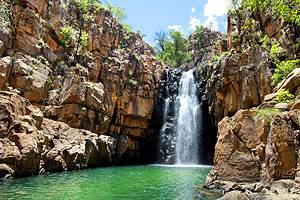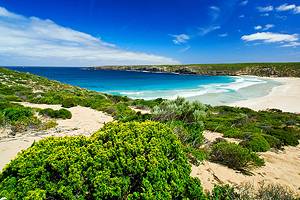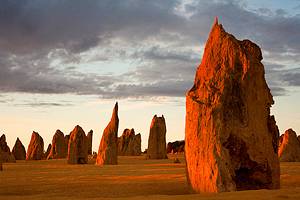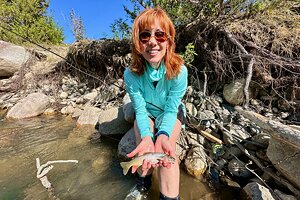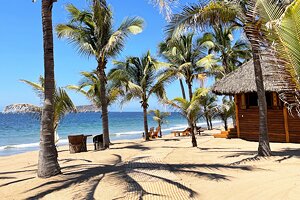16 Top-Rated Hikes in Australia
Walking through Australia's vast wilderness is a ritual woven into the fabric of the nation's past. Thousands of years ago, the country's first inhabitants went "walkabout," a spiritual journey on foot that traced the ancient tracks or "songlines" of their ancestors. Today, you can follow in their footsteps.
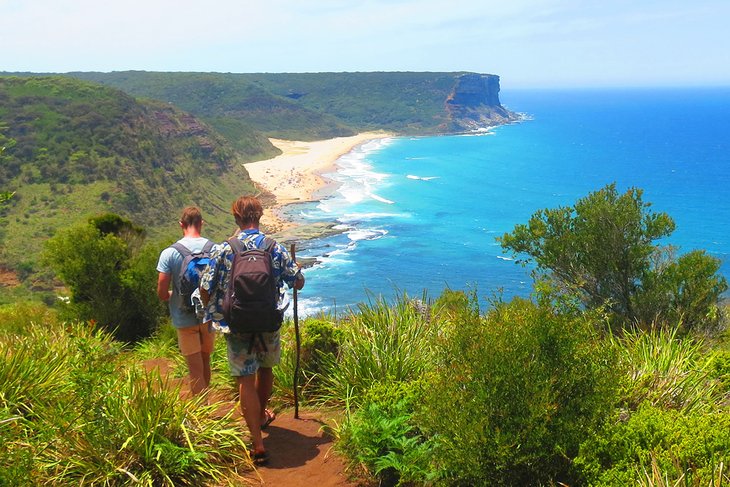
Hikes in Australia cover all abilities, from beginners to hard-core hikers. Take your pick from easy half-day jaunts through bird-rich bushland or strolls along beaches lapped by sapphire seas. Up for more of a challenge? Sign up for a guided multi-day trek in the country's red hot heart, through rugged gorges and red-hued deserts.
Short on time? You can slice up the longer hikes, called the "Great Walks of Australia," into shorter day hikes, depending on your free time and fitness level.
Many of the best bushwalks in Australia weave through World Heritage-listed wilderness areas. Here, you can see some of the country's quirky wildlife, from wallabies and wombats to dingoes, kangaroos, and echidnas. Budding mountaineers can even summit the country's highest peak in less than a day on one of the best alpine hikes in Australia.
Hiking in Australia offers something for everyone, from families to solo hikers, from the coast to the desert. Wherever your walkabout takes you in this wild and sun-soaked land, the spectacular scenery will stir your soul just as it did for the Aboriginal people thousands of years ago.
Plan your adventures with our list of the best hikes in Australia.
- 1. Mount Gower, Lord Howe Island, New South Wales
- 2. Kings Canyon Rim Walk, Northern Territory
- 3. Cape to Cape Track, Margaret River, Western Australia
- 4. Great Ocean Walk, Victoria
- 5. Bondi to Coogee Coastal Walk, New South Wales
- 6. Larapinta Trail, Northern Territory
- 7. Fraser Island Great Walk, Queensland
- 8. Blue Gum Forest, Blue Mountains, New South Wales
- 9. Wineglass Bay Circuit, Tasmania
- 10. Uluru Base Walk, Northern Territory
- 11. Three Capes Track, Tasmania
- 12. Kosciuszko Walk, New South Wales
- 13. Kangaroo Island Wilderness Trail, South Australia
- 14. The Overland Track, Tasmania
- 15. The Bibbulmun Track, Western Australia
- 16. Heysen Trail, South Australia
- Map of Hikes in Australia
1. Mount Gower, Lord Howe Island, New South Wales
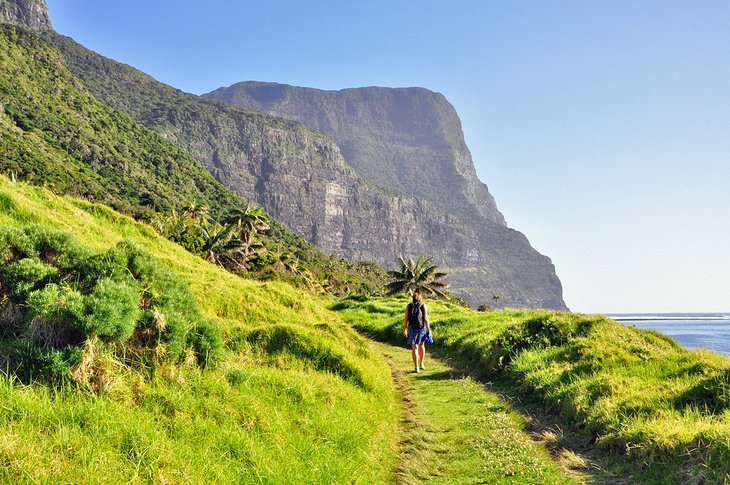
Climbing 875-meter-high Mount Gower on Lord Howe Island is one of the best day hikes in Australia. This World Heritage-listed island lies off the north coast of New South Wales and is one of the top places to visit in the state. From the peak of Mount Gower, you'll have panoramic views of this nature lovers' nirvana.
This 14-kilometer round-trip hike ascends to the mist forests at the mountain's summit. Along the way, you can explore the botanical and wildlife wonders of this pristine island, where visitor numbers are limited to protect the natural environment.
As you climb this lush peak on the island's southern end, fern-filled forests, rare orchids, and moss-cloaked trees imbue the landscapes with a storybook feel. Along the way, you can gape at views of neighboring Mt. Lidgbird; Balls Pyramid, the world's largest sea stack at 565-meters; the lagoon; and the island's northern settlement.
Reaching the summit on this moderate to difficult hike takes about five hours, and the descent takes about four hours, with ledge crossings and rope sections to negotiate along the way. From March through September, the surprisingly fearless providence petrel appears on cue at the summit for close-up viewing.
Guided walks are highly recommended and provide insight into the island's unique ecology and natural history.
2. Kings Canyon Rim Walk, Northern Territory
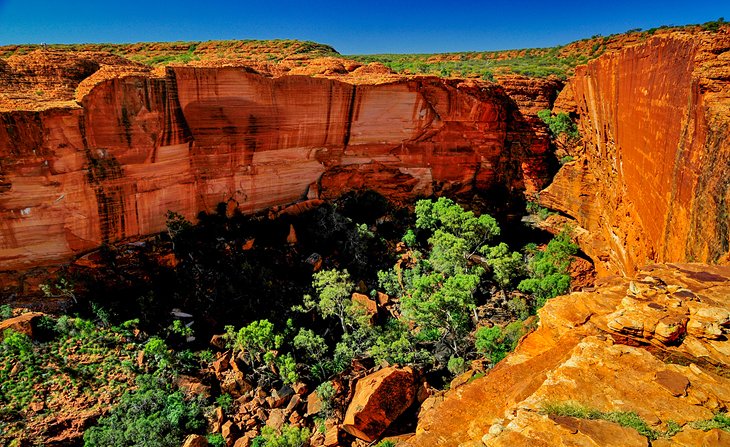
Kings Canyon Rim Walk is one of the country's most famous day hikes. This six-kilometer hike in Watarrka National Park, skirts the lip of a spectacular 150-meter-deep canyon in Australia's Red Centre.
Due to the scorching heat, it's best to begin this three- to four-hour walk before dawn. The rising sun paints the landscape in rich hues of rose gold, and this is also the best time to see wildlife, including kangaroos, zebra finches, and white-plumed honeyeaters.
The first part of the hike requires climbing 500 steps to the rim of the canyon, but it's worth it for the spectacular views. Once at the top, follow the u-shaped trail around the sandstone cliffs and peer below into a wonderland of weathered dome-shaped rock formations; ancient cycads; and the Garden of Eden, an unlikely oasis with lush vegetation and a perennial waterhole. After winter rains, waterfalls tumble down the rock faces here.
The Kings Canyon Rim Walk requires an average to high fitness level and is a one-way loop, so you won't encounter hikers coming in the opposite direction. If possible, avoid hiking in the extreme temperatures from September through May. Take plenty of water, sunscreen, and insect protection.
Hikers seeking a more gentle walk in the canyon can try the easy 2.6-kilometer Kings Canyon Creek walk.
Kings Canyon Resort lies about seven kilometers from here, with accommodation ranging from campsites to plush rooms.
3. Cape to Cape Track, Margaret River, Western Australia
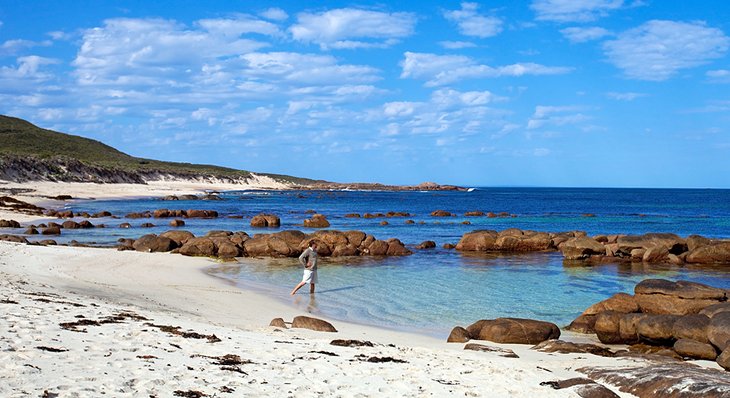
The Cape to Cape Track is one of the best coastal hikes in Australia. Located in the southwestern corner of Western Australia, 260 kilometers south of Perth, this rewarding multi-day hike meanders for 135 kilometers along coastal cliffs, surf beaches, and forests of giant karri trees.
Named for its route between the lighthouses of Cape Naturaliste and Cape Leeuwin, along the Margaret River coast, the entire walk lies within a national park and takes between five to seven days. But you can choose easier sections for half-day or day walks.
Highlights of the Cape to Cape walking track include coastal rock formations, such as jagged Sugarloaf Rock jutting from the sea; cool cascades; squeaky-clean beaches; and sea cliffs with views across the pounding surf. Between June and December, keep an eye out for whales.
One of the most scenic sections of the hike skirts the cliff-tops above Contos Beach, where wildflowers flourish in the spring, and kangaroos often take cover under shady scrub. Another section crosses the mouth of the Margaret River as it flows to the sea.
Campsites lie along the route, as well as a range of more comfortable accommodation, making this a great choice for hikers who prefer not to rough it after a long day of walking. Tour companies also run guided walks along this route.
Official site: http://www.capetocapetrack.com.au/
4. Great Ocean Walk, Victoria
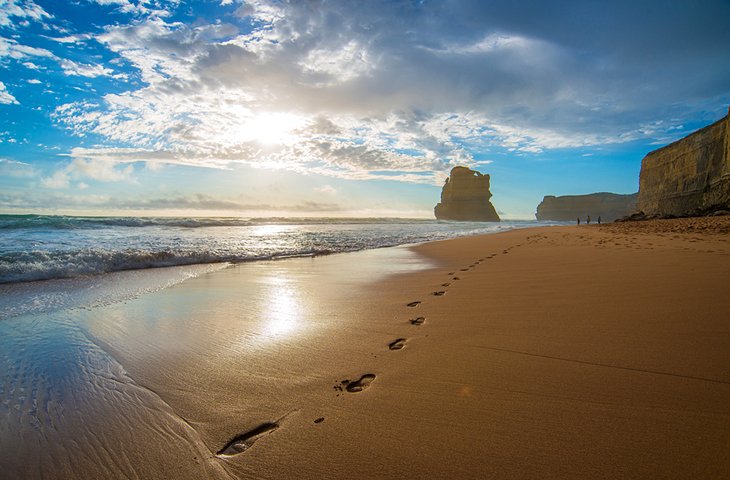
The Great Ocean Road, along Victoria's Shipwreck Coast, is one of Australia's most famous scenic drives, but you can also enjoy the breathtaking scenery on foot.
Carving along one of the country's most spectacular stretches of coastline, this multi day, one-way hike stretches for 104 kilometers, from the town of Apollo Bay through Port Campbell and Great Otway National Parks. It takes up to eight days.
One of the best hikes in Victoria, this epic trek evokes sheer awe in the power of Mother Nature. Perhaps the most famous stretch is from Princetown to Glenample. Here, a clifftop path perches over the famous Twelve Apostles, the towering coastal rock formations sculpted by the howling winds and thrashing surf.
Standing above the treacherous ocean, you can actually imagine how the forces of nature gouged this scalloped coast over millennia. Other highlights include skirting some of the country's highest sea cliffs, wandering through wildlife-rich wetlands and casuarina forests, and descending to windswept beaches where the rusted anchors of old shipwrecks lie. From June through September, look for whales just offshore.
Most of the trek is classified easy to medium, although the Wreck Beach Walk section is more challenging. Accommodation along the way ranges from campsites to ecolodges and posh hotels, and tour operators offer guided walks.
5. Bondi to Coogee Coastal Walk, New South Wales
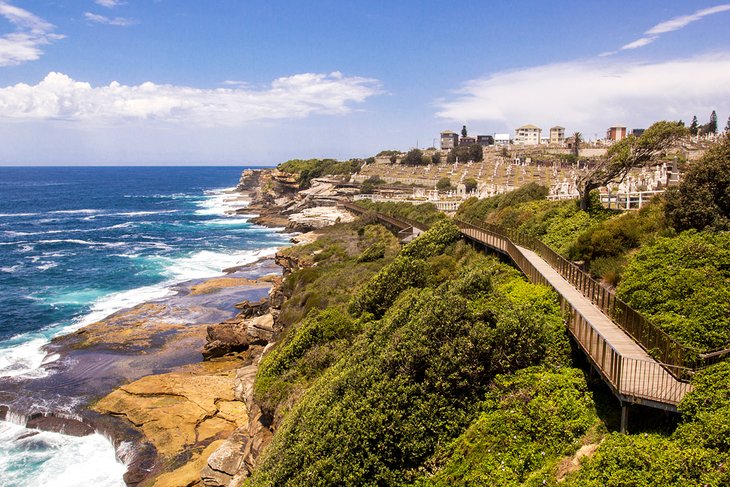
Looking for an easy surf-side city hike? Head to Sydney's famous Bondi Beach to start your ocean-view adventure. Suitable for everyone from beginners to kids, the six-kilometer Bondi to Coogee Coastal Walk is actually more of a stroll than a hike. It traces the bluffs and headlands along Sydney's Eastern suburbs, starting at Bondi's famous Icebergs restaurant. Stop here for some sustenance before you head out.
As you stroll along the sea cliffs, you'll see some of Sydney's best beaches. After iconic Bondi Beach, you'll wander past Tamarama, Bronte, and Clovelly, ending your salty stroll at Coogee. Stop for a coffee along the way, or wander down for a quick dip to cool off in the surf.
This famous Sydney hike takes about two to three hours to complete, depending on how often you stop to enjoy the panoramic coastal views. It's one of the top things to do in Sydney if you want to get a feel of the city's beach culture.
6. Larapinta Trail, Northern Territory
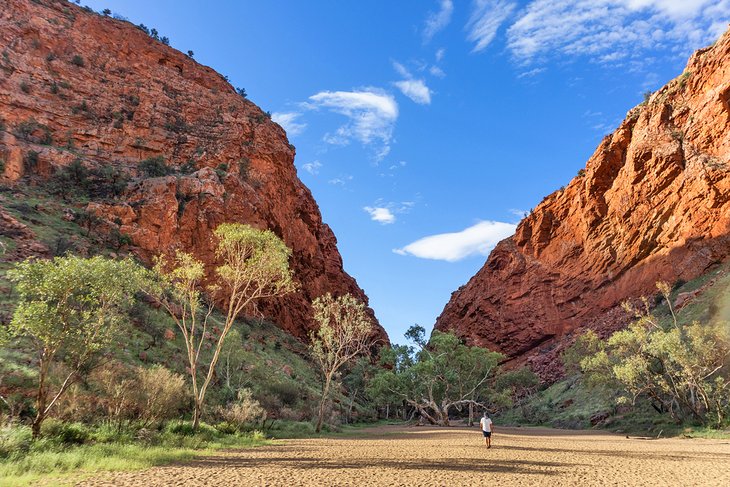
Looking for a quintessential Aussie outback hiking adventure? The remote Larapinta Trail is for you. Located in the Northern Territory, it follows in the footsteps of the country's first inhabitants, across ancient desert landscapes and the rugged spine of the West MacDonnell Ranges.
The entire 223-kilometer track takes up to 14 days and is best tackled by experienced hikers, but you can choose a combination of the 12 separate sections depending upon your time constraints and ability.
Larapinta Trail hikes offer a striking glimpse at stark outback scenery. This multi day hike starts at the old Alice Springs Telegraph Station and weaves west to the dramatic beauty of Simpson's Gap, Ormiston Gorge, and Stanley Chasm. It culminates with a steep climb up Mount Sonder, the highest point of the trail, with 360-degree views over the magnificent desert landscapes.
Sleeping under the star-studded desert skies in a bushman's swag is part of the adventure here, or you can pitch a tent at one of the wilderness camps.
Guided group tours are recommended for this long distance hike due to the harsh climate and its rugged and remote location in Australia's Red Centre.
Official site: http://www.larapintatrail.com.au
7. Fraser Island Great Walk, Queensland
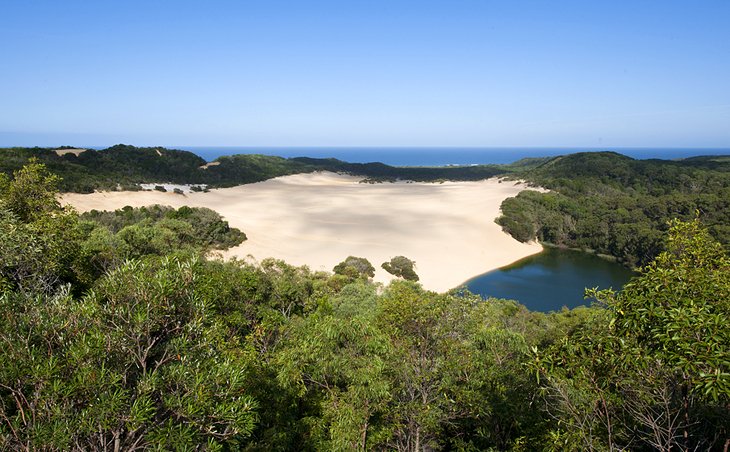
This 90-kilometer walk traces the footsteps of the native Butchulla people on World Heritage-listed K'Gari (Fraser Island). Along the way, you'll visit many of the top tourist attractions of K'Gari, the planet's largest sand island. The trail threads along old logging routes between Dilli Village and Happy Valley, through subtropical rainforest and mangroves, and along the shores of windswept beaches.
Highlights include strolling along the rainforest boardwalk bordering the crystal-clear waters of Wanggoolba Creek, swimming in the striking blue waters of Lake McKenzie, and gazing up at the towering sand dune engulfing Lake Wabby. At Central Station, stop by the exhibits to brush up on the history and ecology of the island.
Want to see some wildlife? While you're walking, look out for dingoes, Australia's wild dog.
This relatively easy walk takes about six to eight days to complete, and you can concentrate on smaller segments if you're short on time. Basic walkers' camps lie along the route, as well as a couple of private guesthouses.
Seeking a little pampering after a hard day's hike? Relax at the 4-star Kingfisher Bay Resort, a popular eco-resort offering everything from hotel rooms to self-contained villas and ocean-view executive houses.
Official site: http://www.nprsr.qld.gov.au/parks/great-walks-fraser-island/about.html
8. Blue Gum Forest, Blue Mountains, New South Wales
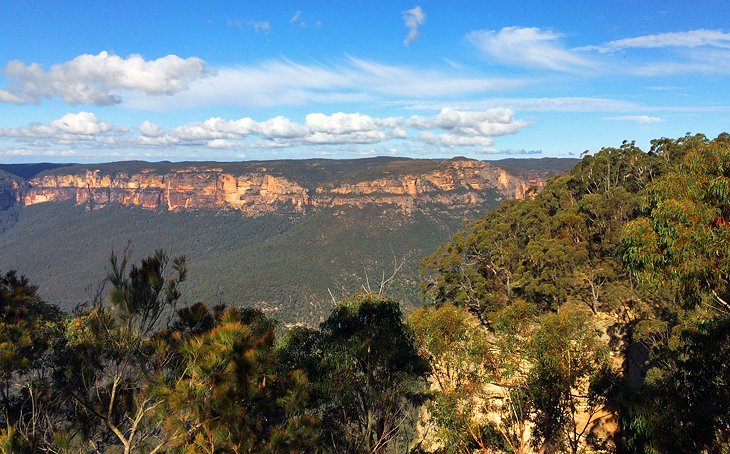
About 115 kilometers from Sydney, the World-Heritage-listed Blue Mountains National Park offers some of the best hikes in NSW. In particular, the steep hike to the Blue Gum Forest has become a kind of spiritual pilgrimage for Aussie bushwalkers. This beautiful 16-hectare forest was saved from destruction in the early 1930s by passionate bushwalkers who pooled funds to buy the land. Today, it graces the list of popular places to visit in this magnificent wilderness area.
You can access the forest on various routes. One of the most popular is the five-kilometer round-trip track from Perry's Lookdown. The hike takes about four hours round trip. Before descending into the Grose Valley, take a moment to enjoy the breathtaking views from the lookout, where eucalyptus forests stretch as far as the eye can see.
Hiking in the Blue Mountains is a sensory feast, and this hike is no different. Cockatoos screech across the valley, water splashes over slick rocks in a cool creek, bark crunches underfoot, and the pungent fragrance of eucalyptus and damp earth infuses the air.
Those who wish to stay overnight can pitch a tent at the Acacia Flat campground nearby. You can also hike to the Blue Gum Forest from the famous Govetts Leap lookout.
9. Wineglass Bay Circuit, Tasmania
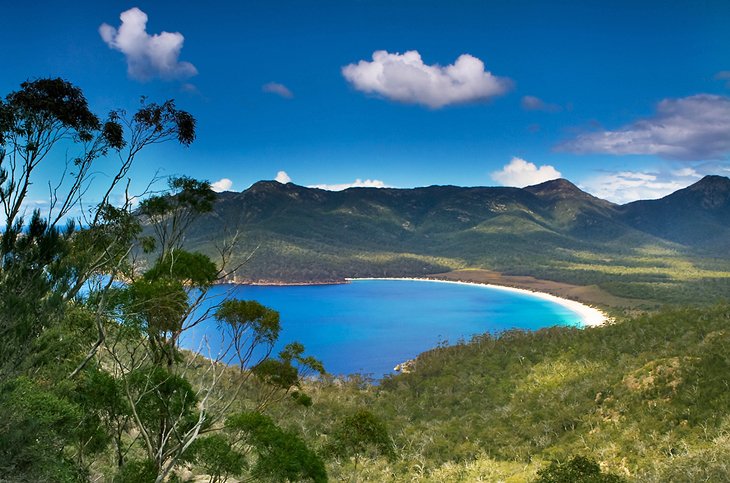
Named for its voluptuous curves, Wineglass Bay in Freycinet National Park is one of the most beautiful beaches in Australia. This ravishing half-moon slice of white sand and sapphire sea forms a dazzling backdrop for one of the park's top walks. Tasmania's Oyster Bay tribe once walked these lands, and now hikers can travel the same ancient routes.
The 12-kilometer Wineglass Bay Circuit walk offers picture-perfect views of this sparkling cove, backed by the pink-tinged granite peaks of the Hazards. The walk rises steeply to the Wineglass Bay lookout, where you can ogle views of the beautiful bay. From here, the track threads through the Hazards and descends to the beach itself. Linger here to soak up the raw beauty.
Another track leads across the isthmus to boulder-strewn Hazard's Beach. Along the way, keep a lookout for some of the park's quirky wildlife, including wombats, wallabies, and the eastern quoll. The walk is easy after the steep climb to the lookout.
The summer months of December through April are the prime time to tackle this hike, when the days are longer and the weather is warmer.
This hike is one of Tasmania's Great Short Walks and forms part of the 30-kilometer Freycinet Peninsula Circuit. It's also one of the best summer hikes in Australia, due to its southern latitude. Accommodation ranges from rustic campsites to luxury ecolodges, like Saffire Freycinet.
10. Uluru Base Walk, Northern Territory
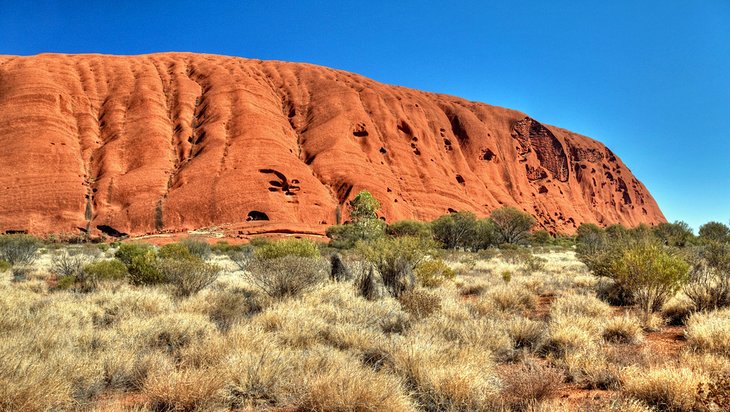
After you've absorbed the beauty of Uluru from a distance, and captured photos of its shifting colors at sunset, do yourself a favor and return at sunrise for a hike around its base. The 10-kilometer Uluru Base Walk circumnavigates this sacred rock, taking you through the changing landscapes, from lush foliage to acacia woodlands, waterholes, stands of bloodwood trees, and bare sun-scorched desert. It's a great way to get a different perspective of this famous Northern Territory tourist attraction.
Walking around the rock takes you up close to see the etchings and ever-changing colors of the rock's surface. The track is well-marked and flat, and interpretive signs along the way share fascinating details about the ecology and the rock's significance to the local Anangu people. Better still, book an Aboriginal-guided hike to learn more about the cultural significance of this iconic landmark and its surroundings, including how to find bush tucker (food).
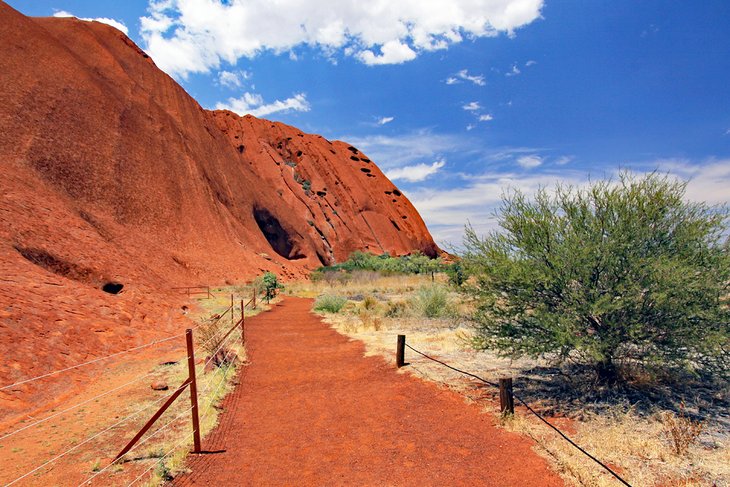
It takes about three to four hours to complete the trail, with stops along the way. The best way to tackle the hike is to start at the Mala carpark in the early morning, when the weather is cooler, and walk around the rock in a clockwise direction. Make sure you respect the local people's culture and refrain from taking photos at sensitive points along the trail – signs will warn you where photography is not allowed.
This is one of the best family hikes in Australia, as long as you time it for the coolest part of the day. Note that parts of the trail close when temperatures soar during summer afternoons due to the danger of heat stroke.
Now that tourists are banned from climbing the rock out of respect for the local people, the Uluru Base walk is one of the best ways to appreciate its beauty.
11. Three Capes Track, Tasmania
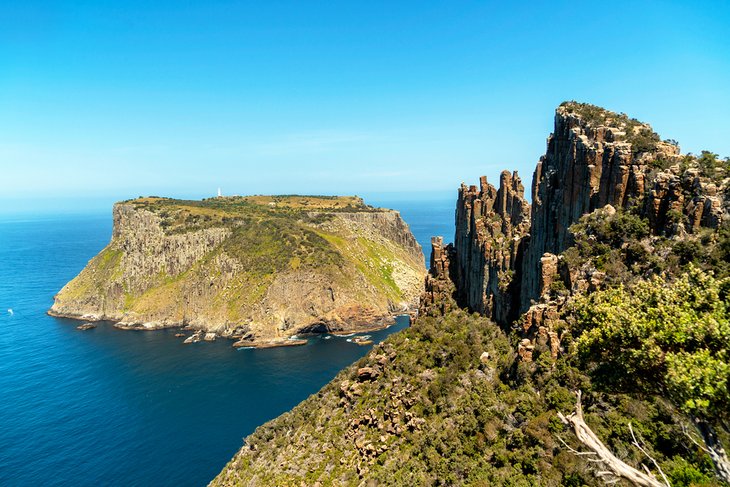
Imagine walking along the edge of a continent, with nothing between you and Antarctica except the wild and wind-whipped Tasman Sea. This is the Three Capes Track.
Starting and ending near World Heritage-listed Port Arthur, the 48-kilometer Three Capes Track carves through the windswept wilderness of Tasman National Park, and it's one of the top things to do in Tasmania.
This hike is so remote, you have to take a boat to the trailhead from Port Arthur. Once you get here, nature's drama draws you in. Sheer cliffs plunge to the sea, spectacular dolerite columns loom skyward, and eucalyptus forests scent the salty air. Most of the hike weaves through colorful coastal heath, with jaw-dropping views of the ocean, but you'll also wander through dense forests, and descend to wild bays.
Wildlife is another highlight. Wombats, wallabies, and echidnas are just some of the Aussie creatures you might meet along the way.
This hike truly is unique, and it's a great way to celebrate a milestone. Every hiker receives an Encounters on the Edge guidebook with maps and notes about the journey, as well as stories to read as you sit on benches gazing out at the breathtaking views along the track. This four-day, three-night hike is suitable for all levels of hikers – even children.
Wondering where you'll stay in this rugged paradise? Comfy eco-friendly cabins await for you to rest your weary legs along the way, making this one of the best overnight hikes in Australia.
Official site: https://www.threecapestrack.com.au/experience.html
12. Kosciuszko Walk, New South Wales
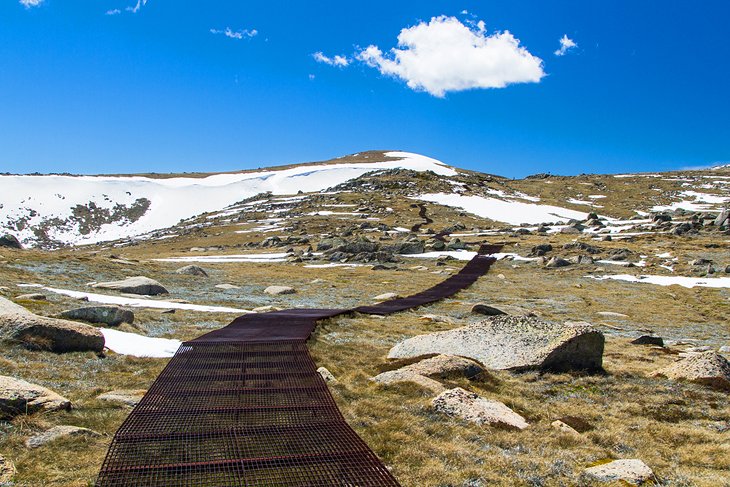
If you've always wanted to summit a county's highest peak but you're not much of a mountaineer, you're in luck. On the Kosciuszko walk, you can enjoy a round-trip hike to the 2,228-meter summit of Mount Kosciuszko, Australia's highest peak, in less than five hours – with a little help from Thredbo's Kosciuszko Express chairlift.
From June through October, this well-maintained and clearly-marked track is usually covered in snow, so the 14-kilometer loop is best attempted in summer. Take the chairlift up as far as you can go, and from here, the track ascends past the rugged granite outcrops of the Rams Head Range, through wildflower-flecked heathlands and past Lake Cootapatamba, which was gouged by glaciers.
Pause at the lookout to admire spectacular views of Australia's alpine country. You'll also cross over the humble headwaters of the Snowy River from the famous bush ballad, The Man from Snowy River, by Banjo Paterson.
This is a great moderate walk for budding mountaineers (and even older children) who want a summit hike but are not quite ready for an expedition to Everest. You can easily tackle the walk independently. Make sure you dress in layers and take plenty of water.
Official site: http://www.nationalparks.nsw.gov.au/things-to-do/walking-tracks/kosciuszko-walk-thredbo-to-mount-kosciuszko
13. Kangaroo Island Wilderness Trail, South Australia
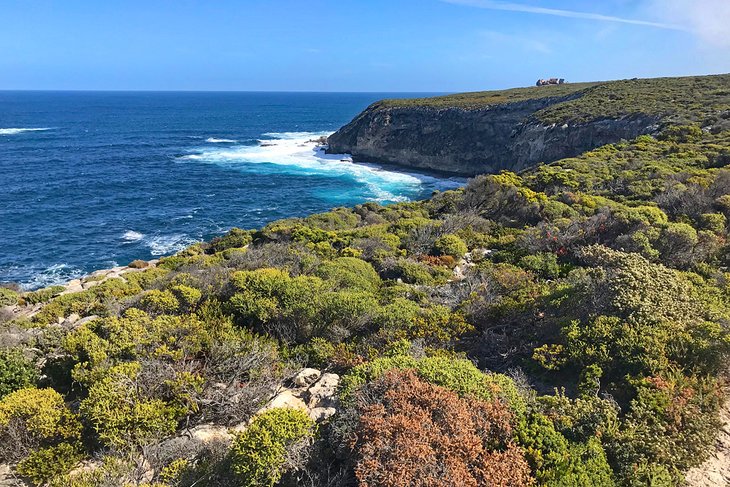
The Kangaroo Island Wilderness Trail is one of the best ways to appreciate this island's rugged, windswept beauty. It skirts limestone cliffs overlooking the wild sea on the south-west coast of Kangaroo Island, one of the top places to visit in South Australia.
This five-day, 61-kilometer track is one of the best multi day hikes in Australia. It starts in Flinders Chase National Park and also weaves through Cape Bouguer Wilderness Protection Area, and Kelly Hill Conservation Park. Along the way, you'll see some of the top attractions in Kangaroo Island, including Admirals Arch, Remarkable Rocks, Weirs Cove, Hanson Bay, and Kelly Hill Caves.
Plus, you'll have plenty of opportunities to spot iconic Aussie wildlife. Kangaroos, koalas, goannas, echidnas, and wallabies are some of the creatures that inhabit the coastal bushland. Look out to sea, and you can sometimes spot whales, seals, and ospreys.
Besides the wildlife, other highlights include the jagged wind- and sea-sculpted limestone stalagmites rising from the headland.
In 2019 and 2020, fires damaged much of the trail, but it has now been upgraded and restored. Best of all, nature is making a comeback. Today, you can see the plants and trees regenerating. You'll also have better views of wildlife, as well as breathtaking new coastal vistas that were once shielded by dense bush.
Note that while the bushland is recovering, access to the Kangaroo Island Wilderness Trail is limited. You need to book your hike in advance with a licensed tour operator.
Good footwear is essential for this hike due to the sharp limestone shoreline. Fall and spring are the prime times to hike, when temperatures are milder.
14. The Overland Track, Tasmania
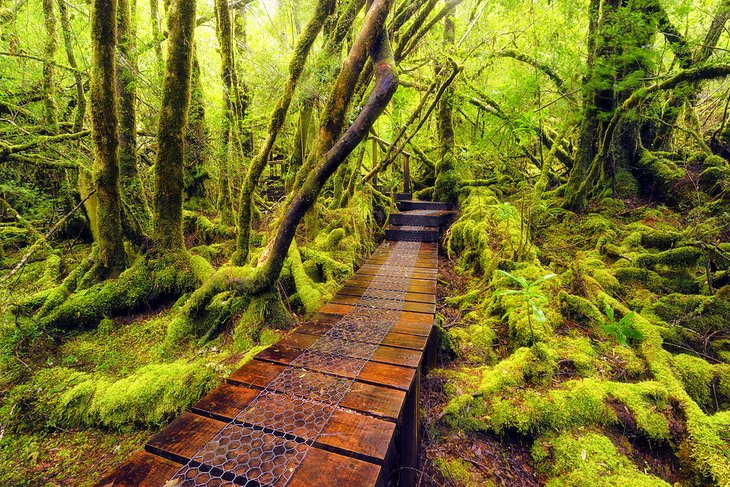
If pristine alpine environments and gob-smacking natural beauty tickle your fancy, sign up for the Overland track. This epic one-way trail, which takes on average about six days, meanders through spectacular Cradle Mountain-Lake St. Clair National Park, part of the Tasmanian Wilderness World Heritage Area, and one of the state's top attractions.
The hike begins at Cradle Mountain and culminates at glittering Lake St. Clair, Australia's deepest lake. Along the way, you'll see misty moorlands, deep valleys cut by glaciers, waterfalls, toothy granite peaks, primeval rainforests, and alpine meadows flecked with wildflowers.
The trail runs for 65 kilometers or around 80 kilometers if you choose to walk along Lake St. Clair for an extra day. You can also opt for side trips to other areas of the park, including Mount Ossa, Tasmania's highest peak.
This is one of the most challenging alpine trails in Australia and requires a high level of fitness – more than half of it exceeds 304 meters in elevation. Make sure you book online at least 24 hours in advance. Note also that the weather can be capricious – it's important to pack gear for wet, cold, and windy weather, even in the summer.
If you're looking for even more of a challenge, plan a hike up Federation Peak in Tasmania's Southwest National Park. This 1,274-meter-high rock spire in Eastern Arthur Range is one of the hardest hikes in Australia. But it's not for the faint of heart.
15. The Bibbulmun Track, Western Australia
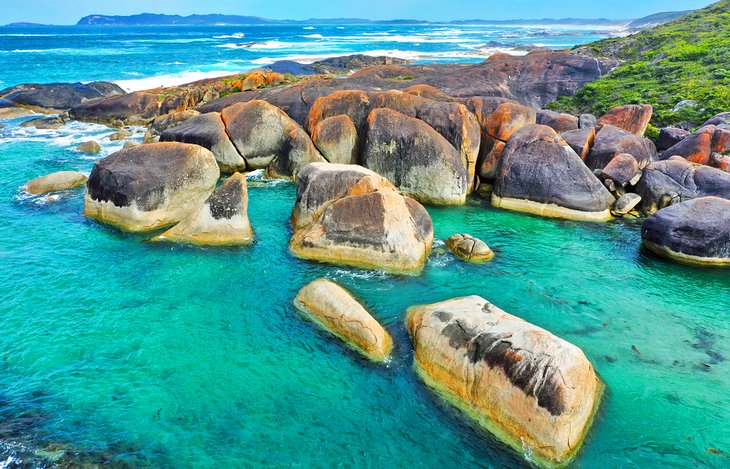
Hiking in Western Australia can take you through some of the most breathtaking scenery in Australia, and the Bibbulmum Track covers some memorable highlights. This one-way 1,000-kilometer, long distance hike starts from Kalamunda, on a walking trail in the Perth hills, and explores some of the most scenic national parks in the state's southwest, ending in the coastal town of Albany.
Highlights include wandering through the giant karri, jarrah, and tingle forests; seeing the sights of William Bay National Park; breathing in the salty air in ocean-view heathlands; and catching sight of kangaroos peeking out from purple spring wildflowers in the misty valleys.
The trail travels through land owned traditionally by the Nyoongar people, and it's easy to find your way. Markers appear every 500 meters or so, displaying the Waugul rainbow serpent of Aboriginal Dreaming. You'll also find campsites at regular intervals, with basic shelters, pit toilets, and rainwater tanks.
Best of all, you can tailor the experience to suit your comfort level and experience, from a self-guided, eight-week, long distance hike to shorter guided tours. Prefer to do day hikes with more comfortable digs? You can stay in towns along the way and tackle shorter hikes in each area.
The best time of year to hike the track is in the Southern Hemisphere's autumn, winter, or spring, when the wildflowers burst into bloom. Summer can be too hot for hiking – especially along more exposed areas of the trail.
Official site: https://www.bibbulmuntrack.org.au/
16. Heysen Trail, South Australia
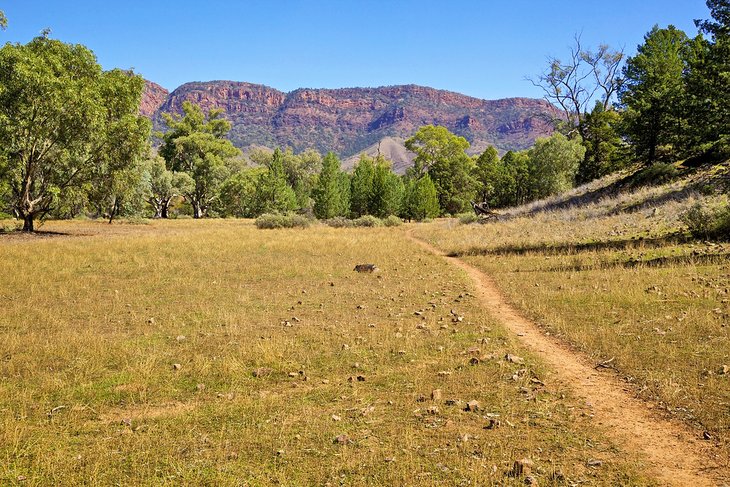
Wondering about what is the longest hike in Australia? You'll find it in South Australia. The 1,200-kilometer Heysen Trail stretches from Cape Jervis on the south coast of the Fleurieu Peninsula to Parachilna Gorge in the Flinders Ranges, but you can break it up into a series of half-day hikes. Think you want to tackle the entire hike? Make sure you have at least 60 days up your sleeve.
This epic trail is named after German-born Sir Hans Heysen (1877-1968), a famous Australian landscape artist. Heysen painted water colors of the Australian bush, including the Mount Lofty and Flinders Ranges. Now you, too, can be inspired by the vibrant vistas along this iconic track.
Highlights take you through some of the top places to visit in South Australia. These include the surf-washed scenery of the Fleurieu Peninsula, especially Deep Creek National Park; the bucolic vistas of the Barossa Valley, one of Australia's oldest grape-growing regions; the Adelaide Hills; and the Flinders Ranges. If you're a beginner hiker, or you're hiking with children, opt for the sections closer to Adelaide and the South Coast. The more remote areas can be challenging and are best for experienced hikers.
Note that due to wildfire risk, parts of this trail are seasonal and are only open from May through November. Check before you head out. Also, upgrades are underway for the Wild South Coast Way section of the Heysen Trail, from Cape Jervis to Victor Harbor and are due to be completed in 2023. This will include accessible trails for people with limited mobility.
Official site: https://heysentrail.asn.au/heysen-trail/
Map of Hikes in Australia
More Related Articles on PlanetWare.com
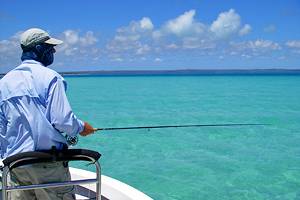
More Aussie Outdoor Adventures: If you're looking for adrenaline-infused activities in the fresh air and sunshine, check out our article on the Top-Rated Outdoor Adventures in Australia. Climb the Sydney Harbour Bridge, zipline through the Daintree Rainforest, or abseil in the Blue Mountains. Are water sports more your style? Australia has some fantastic fishing destinations, whether you want to fly fish for trout in a mountain stream or catch a marlin on a deep-sea fishing trip. And if you're looking for the best place to surf, swim, and snorkel, check out our list of the best Aussie beaches, from Whitehaven to Wineglass Bay.


